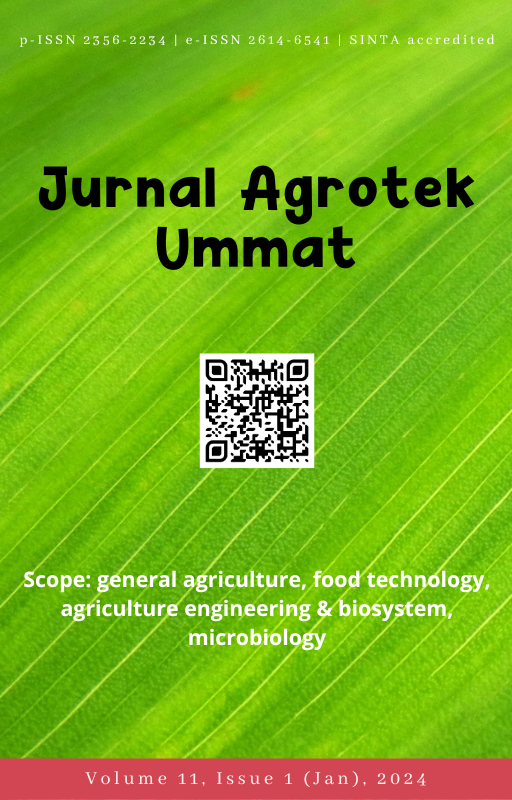Analysis of growth and wilting point of chili (Capsicum annum L.) seedlings using three types of planting media
DOI:
https://doi.org/10.31764/jau.v11i1.19816Keywords:
growing media, plant growth, wilting pointAbstract
Cayenne pepper plants are one of the plants that are susceptible to excess and lack of water during their growth period. Lack of water can cause chili seeds to not grow optimally, so chili plant nurseries need ideal media to be able to provide optimal water. This research aims to determine the growth and duration of the permanent wilting point in the growth of chili plant seeds based on differences in planting media in the form of magot compost, soil containing pumice and paddy soil under conditions without watering. The treatment in this research used three different planting media, namely compost, pumice, and paddy soil media. Providing water to chili plants by watering 3 times a day and without watering. The research method uses experimental methods with observations in the greenhouse and there are three treatments, namely using magot compost, pumice and soil media. The parameters observed included growth in height, number of leaves, and width of the plant leaves as well as the length of time to the permanent wilting point. The data from the research were analyzed using ANOVA with the help of SPSS. The results of the research showed that the compost media had the best growth with a height of 9 cm, the number of leaves was 6 pieces, and leaf width 2.9 cm, while the permanent wilting point duration of the three media used was found in compost media, which experienced the longest permanent wilting point at the age of 10 days. So it can be concluded that the best planting medium is found in maggot compost media with the highest growth and longest wilting point.
References
Dewi, N., Danial, E. and Prameswari, A. D. (2022) ‘Respon Pertumbuhan dan Produksi Tanaman Pakcoy (Brassica rapa L.) terhadap Pemberian Pupuk Kandang Kambing dan Urea’, Jurnal Ilmiah Fakultas Pertanian, 3(2), pp. 23–28.
Fathoni, A. and Wahyuni, I. (2023) ‘Analisis berat jenis dan kapasitas air pada kompos magot dan pada tanah mengandung pumice di pulau Lombok Bulk density and water capacity analysis at magot compost and at soil containing pumice on Lombok Island’, 10(2), pp. 186–194.
Gaus, A. et al. (2022) ‘Effects of Using Pumice Sand as A Partial Replacement of Fine Aggregate in Lightweight Concrete Mixtures’, IJEBD (International Journal of Entrepreneurship and Business Development), 5(4), pp. 660–666. doi: 10.29138/ijebd.v5i4.1882.
Habib, I. M. Al, Sukamto, D. S. and ... (2017) ‘Potensi Mikroba Tanah Untuk Meningkatkan Pertumbuhan Dan Hasil Tanaman Cabai Rawit (Capsicum frutescens L.)’, Folium Jurnal Ilmu ….
Hakim, M. F. (2012) Modifikasi Inline Emitter Untuk Sistem Irigasi Tetes Bawah Permukaaan Tanah (Subsurface), Universitas Negeri Lampung.
Haridjaja, O. et al. (2013) ‘Perbedaan Nilai Kadar Air Kapasitas Lapang Berdasarkan Metode Alhricks , Drainase Bebas , Dan Pressure Plate Pada Berbagai Tekstur Tanah Dan Hubungannya Dengan Pertumbuhan Bunga Matahari ( Helianthus annuus L .) Different Levels of Field Capacity by Alhri’, 15(2), pp. 52–59.
Istiqomah, A. . K. (2016) ‘Effect of Composition Growing Media and Nutrient Solution for Growth and Yield Pakcoy (Brassica rapa L. Chinensis) in Hydroponic Substrate’, PLANTROPICA Journal of Agricultural Science. 2016, 1(1), pp. 6–11.
Mamonto, R., Rombang, J. A. and Lasut, M. T. (2019) ‘Pengaruh Media Tanam Terhadap Pertumbuhan Semai Aquilaria malaccensis Lamk. di Persemaian’, Cocos, 1(1), pp. 1–14.
Nurhafsah, N. et al. (2021) ‘Analisis Usahatani Cabai di Luar Musim Berdasarkan Penerapan Komponen Budidaya Cabai Merah di Provinsi Sulawesi Barat’, Jurnal Teknotan. doi: 10.24198/jt.vol15n1.2.
Patil, Ravi et al. (2018) ‘Water productivity of tomato as influenced by drip irrigation levels and substrates’, Journal of Pharmacognosy and Phytochemistry.
Ridha, M. and Darminto, D. (2016) ‘Analisis Densitas, Porositas, dan Struktur Mikro Batu Apung Lombok dengan Variasi Lokasi dan Kedalaman’, Jurnal Fisika dan Aplikasinya, 12(3), pp. 124–130. doi: 10.12962/j24604682.v12i3.1403.
Sari, E. and Fantashe, D. (2015) ‘Pengaruh Jenis Media Tanam Terhadap Pertumbuhan Vegetatif Tanaman Cabai Rawit (Capsicum frutescens L.)’, Bio-Lectura, 2(2), pp. 129–139. doi: 10.31849/bl.v2i2.323.
Selvamurugan, M. et al. (2018) ‘Effect of drip fertigation and plastic mulching on growth and yield of tomato’, Journal of Applied Horticulture. doi: 10.37855/jah.2018.v20i01.14.
Setiaji, A. (2020) ‘Effect of Different Strenght of Medium on Germination and Seedling Growth of Tomato and Sucrose Effect on Biomass of Tomato Callus’, Jurnal Biota, 6(1), pp. 12–18. doi: 10.19109/biota.v6i1.4184.
Widodo, K. H. et al. (2018) ‘Pengaruh Kompos Terhadap Sifat Fisik Tanah Dan Pertumbuhan Tanaman Jagung Di Inceptisol Effects of Compost on Soul Physical Properties and Growth of Maize on an Inceptisol’, Jurnal Tanah dan Sumberdaya Lahan, 5(2), pp. 2549–9793. Available at: http://jtsl.ub.ac.id.
Downloads
Published
Issue
Section
License
Authors who publish articles in Jurnal Agrotek Ummatagree to the following terms:- Authors retain copyright of the article and grant the journal right of first publication with the work simultaneously licensed under a CC-BY-SA or The Creative Commons Attribution–ShareAlike License.
- Authors are able to enter into separate, additional contractual arrangements for the non-exclusive distribution of the journal's published version of the work (e.g., post it to an institutional repository or publish it in a book), with an acknowledgment of its initial publication in this journal.
- Authors are permitted and encouraged to post their work online (e.g., in institutional repositories or on their website) prior to and during the submission process, as it can lead to productive exchanges, as well as earlier and greater citation of published work (See The Effect of Open Access).

